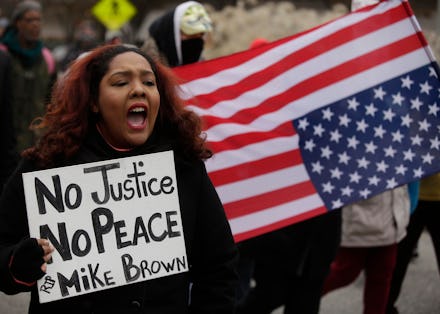Michael Brown Shooting to Ferguson Unrest: 5 Pivotal Moments to Remember

Residents of Ferguson, Missouri, certainly haven't forgotten the events of Aug. 9, 2014. On that Saturday, Darren Wilson, a white police officer, fatally shot 18-year-old Michael Brown, an unarmed black man, in what appeared to be an unnecessary use of deadly force.
The shooting sparked widespread and sometimes violent protests, a federal investigation, a national conversation about police brutality and, most of all, heartache.
One year after the Brown shooting sent shock waves across the country, the St. Louis suburb has kept the young man's memory alive. Activists say they have planned peaceful vigils and protests in Ferguson to mark the anniversary of Brown's death. Scheduled events include marches and documentary screenings, among other events, according to Time. But planned peaceful protests turned to riots throughout the night.
Months later, a grand jury ultimately chose not to indict the officer in the shooting. Wilson has since been unemployed and in hiding on the outskirts of St. Louis.
Here's a look back at some of the pivotal moments to remember from the Brown shooting:
Aug. 9, 2014: Wilson was patrolling when he got a notification from police dispatch that two men had robbed a convenience store, according to a Department of Justice report. Shortly afterward, Wilson saw Brown and his friend Dorian Johnson (who had just stolen packages of cigarillos from a nearby store) walking down the street.
The men matched the descriptions Wilson had received from dispatchers. After Wilson stopped the two men, a confrontation ensued, and both Brown and Johnson fled.
At one point, Brown turned to face Wilson, who subsequently fired 12 rounds, striking the 18-year-old six times, including twice in the head.
Aug. 10, 2014: As news of the shooting spread, and more and more details about the encounter between Brown and Wilson emerged, peaceful vigils gave way to rioting. Protesters chanting "Hands up, don't shoot!" and "No justice, no peace!" took to the streets in the days following the shooting to demand justice for Brown.
Law enforcement flooded the area, and heavily armed riot police used tear gas to disperse crowds. Authorities escalated the situation with what many said were heavy-handed tactics.
Aug. 11, 2014: The Federal Bureau of Investigation said it was opening a civil rights inquiry into the shooting.
"The Bureau will take a lot of the information that we have developed already, they'll take that information, they may do their own interviews, they may look at the evidence themselves," St. Louis County Police Chief Jon Belmar said during a news conference that day.
Aug. 15, 2015: Authorities identified Wilson as the police officer involved in the shooting. His name had not previously been released to the public over concerns that he would be targeted by rioters. The announcement came after five days of unrest in Ferguson over the shooting.
Aug. 18, 2015: Missouri Gov. Jay Nixon called in the National Guard on the ninth day of civil unrest in Ferguson and after curfews failed to dispel protests.
On Tuesday, Nixon spoke about the one-year anniversary of the Brown shooting, saying he was "confident" local law enforcement had "adequate resources" to quell any protest should it occur, but that there should be room for people to "express themselves."